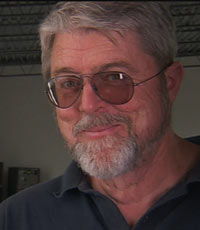


James Sanborn, the mastermind behind Kryptos, obtained his M.F.A. in sculpture from the Pratt Institute in Brooklyn in 1971 before spending a decade at Maryland's Glen Echo Park, a national park for the arts. There, he served as artist-in-residence and taught classes on his craft. Sanborn has had exhibits of his work at the High Museum of Art in Atlanta, the Los Angeles County Museum of Art, and the Smithsonian Institution's Hirshhorn Museum. He has also been commissioned to sculpt pieces for the Massachusetts Institute of Technology, the Central Intelligence Agency, and the National Oceanic and Atmospheric Administration. Sanborn's work is defined in part by his use of natural materials, such as quartz, sandstone, and copper, which he incorporates in part to evoke feelings of mystery in his audience. Kryptos, which has stood in the CIA courtyard since 1990, remains only partially solved today. |
On July 30, 2007, Jim Sanborn answered selected viewer questions about his sculpture Kryptos, including ones about the unsolved fourth part. Please note we are no longer accepting questions, but see our links and books section for additional information. Q: What about cryptography interests you? Did you ever work with codes as a child? A: I never worked with codes in my youth—I was mathematically illiterate. Q: Of the natural materials you have used in your creations, which have you found to be the most interesting? A: Lodestone and uranium Q: What is your favorite kind of encryption, and why? A: Matrix codes (bar codes) are special. They are more "art-like." Q: How many ways of cracking codes do you know? A: 50+ Q: What was your inspiration in making Kryptos? Was it solely to stump would-be code-breakers, or was there another reason behind it? A: I was always fascinated with spies and the secret ways in which they communicated. I also wanted the artwork to retain a sense of mystery. Q: Do those who don't have access to the CIA grounds have enough information to solve Kryptos? A: Yes. Q: Based upon the methodology of the partial solutions to Kryptos to date, do you still believe that further progress can be made as though by a single operator using "pen and paper" methods? A: Anything is possible. Q: Isn't one of the points of creating art letting the viewer determine how the piece affects, interacts with, or speaks to them individually? Why take on definitive pieces? Or would you consider the encryptions indeterminate? A: My encryption phase ended 15 years ago. My art has since been varied, to say the least. [Editor's note: To learn more about Jim Sanborn's artistic endeavors, see Elonka Dunin's page on the sculptor.] Q: What is your next project? A: I am recreating the particle accelerator that split the first atom of uranium in the United States. Q: Are these puzzles fun to create, and why do you create them? A: At the time I did Kryptos, the codes were more fun. Now, they are hard. [Editor's note: Sanborn chose to group together his answer to the following questions.] Q: You have three people trapped in a room trying to crack K4, the yet-unsolved fourth segment of Kryptos. One is a mathematician, one is a geologist, and one is a historian. Who has the best chance at solving the last piece of the sculpture? Q: If you could describe K4 geometrically, how many dimensions would it have and what shape would they be? Q: Does the shape of the Kryptos serve any purpose in the encryption? Q: Will the solution to "K4" come out piece by piece, or will it all pop out at once? Q: Would it be possible to decrypt K4 without prior knowledge of K1, K2, and K3? Q: Could the underlying message of Kryptos be ascertained without decrypting part four? A: I have already given all of the clues that I want to give. Q: You have said that as far as you know the last part has not been solved by anyone, publicly or privately. How do you feel about that? A: Smug. Q: Does K4 have a solvable answer, or is it unsolvable—a sort of metaphor for the endless depths of human curiosity? A: Yes, it has a solvable answer. And I hope it continues to be of interest to many. Q: Are you willing to sell the answer to Kryptos? A: No! Q: Do you intend to reveal the solution at some point, or are you comfortable with taking the solution to your grave? A: The solution to Kryptos may outlive me. If so, arrangements have been made that will allow decryptions to be checked against the solution.
|
||||||||||
|
|
|||||||||||
|
© | Created July 2007 |
|||||||||||